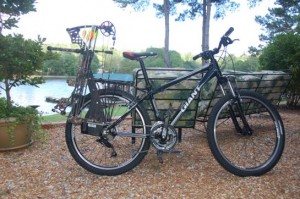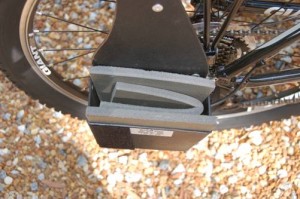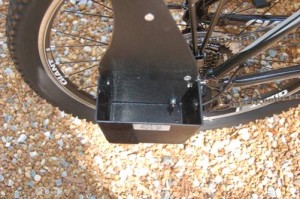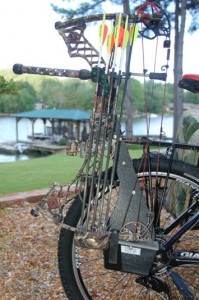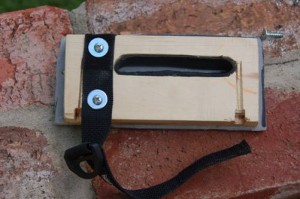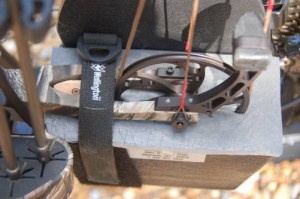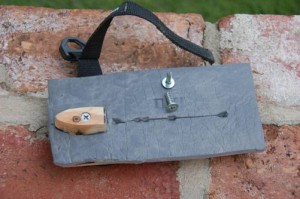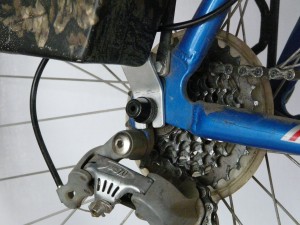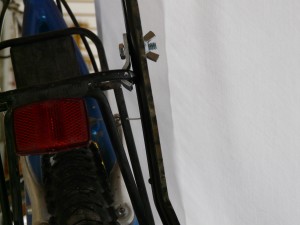By: John Haviland
Last fall my family hung on the handlebars of a dilemma: Was shooting from vehicles ethical when blue grouse were flushing all around? With sweat running down our faces from pumping bicycles up a mountainside, we decided that shooting from these vehicles was not only ethical but eminently sporting.
Every year more roads and trails are closed to motorized vehicles, making many choice deer ridges and grouse bottoms unreachable by hiking hunters. But with the aid of a mountain bike, hunters can pedal these untraveled paths to reach the heart of the best hunting.
The U.S. Forest Service’s Northern Region alone contains 50,000 miles of roads and 23,000 miles of trails. ” That’s a lot of opportunity for mountain bikers,” said Donna Sheehy, the region’s assistant road management engineer.
Sheehy said the Forest Service closes roads for a variety of reasons- to reduce erosion, protect water quality, or provide a more secure home for game and other animals, including grizzly bears.
A road may be closed to motorized vehicles for as short a period as a month- during the wet weather of spring to reduce erosion, for example- for several months during hunting season to provide walk-in hunting, or permanently to protect wildlife.
“I don’t know of any road closures, though, that restrict bicycles.” Shelly said. “The forests are wide open to bikes.” About the only places mountain bikes are prohibited are in designated wilderness areas, where all mechanical devices, including bikes, are prohibited. However, road-closure restrictions vary, depending on the specific intent of the closure. Some permit trail bikes and ATVs; some do not.
Sheehy suggested that hunters buy a visitor/travel map of the forest they plan to hunt. These maps show open and closed roads. however, to find out the latest closure details, it’s a good idea to call the ranger-district office in the area you’ll be hunting. To get those numbers, call the Forest Service regional office listed in the sidebar accompanying this article.
In addition, you’ll need a topographic map, which indicates the steepness of roads, something hunters traveling by pedal power will want to know. “Most Forest Service roads are 12 percent grade or less,” Sheehy said. Most roads have a six to eight percent pitch, which is a fairly easy climb for a bicycle hunter in decent physical shape.
Shape is a relative term. when my son Paul was 14 years old, he figured he needed a bear hide to keep him warm at night. So when Montana’s spring bear season opened, we headed into the mountains, parked at a locked gate, and pulled out our bikes. Paul eagerly took the lead. Every mile or so he coasted back down the road to see what was keeping the Old Man. He would circle around me on his bike, offering words of encouragement, then pedal back up the hill. After five miles I started seeing signs of bears feeding on the spring grass. I kept Paul with me then and told him we were hunting now, not out for a bike ride. We slowly moved along, leaving our bikes once in awhile to check the edges of openings in the forest for the shiny black of a bear.
We had pedaled seven miles into the backcountry when we spotted a bear. Paul quietly laid his bike on its side and pulled out his 7mm-08. We stalked within sure range of the bear and stopped.
“Well?” I whispered into Paul’s ear.
Paul settled into a sitting position. The bear fell dead at the shot. After the excitement waned, Paul asked, “How are we going to carry him all the way back to the car?”
“I’ll show you,” I replied. I set to skinning the bear and boning out the meat. I cinched the meat to the rear rack on my bike and the rolled-up hide to Paul’s. Instead of trudging two hours out on foot, we were back to the car after a leisurely 30-minute downhill coast.
Paul’s bear was a result of the sweat rule that states: The farther away from an open road, the better the hunting. Of course, rules can be bent. When my youngest son was 10, he had the heart of a hunter but skinny legs. He loved going along grouse hunting with the family, but he usually ran out of gas after a few hours of walking. One evening while studying a Forest Service map, I noticed a main access road that went all the way to the top of a mountain. At the top another road branched off into a different drainage and ran 12 miles down to the valley floor. The map showed a red bar across the top and bottom of the road, indicating that it was closed to motorized vehicles.
The following Saturday dawned clear and cool. We loaded the bikes in the pickup and drove to the top of the mountain. My wife and three sons ducked under the locked gate and pedaled off in search of grouse. I drove back down in the valley and parked at the bottom of the road. Early that afternoon the bicycling hunters arrived at the gate, my 10-year-old leading the pack.
PACKING A LOAD
Gordon Miltenbergher of Maryland uses his bike to pedal two miles to his whitetail stand in a wildlife refuge. Miltenbergher told me he likes using a bike because it’s quiet and leaves no human scent on the ground. A couple seasons ago Miltenbergher shot a buck from his stand. He loaded the deer on his bike and headed for his car, an orange vest draped atop the load for safety. Along the way he met a man out for a walk. “Oh,” exclaimed the passerby, “I see you have a passenger.”
To pack a sizable load, like camping gear or game, you need a rack over the rear tire. Eighty pounds is about as much as you should pack on a bike. If you have a lot of weight, it is better to walk the bike than ride it. Your added weight bouncing on the bike may bend the rack or even the bike frame.
One fall my son Paul killed a big four-point mule deer two miles behind a locked gate on U.S. Bureau of Land Management ground. The buck weighed a good 170 pounds field-dressed. There was no way the whole deer would balance on one bike, so we cut the deer in half between the third and fourth ribs. Paul carried the hindquarters tied over thereat and rear rack of his bike, walking the loaded bike the two miles out to the pickup truck without breaking a sweat.
That same fall I met two successful elk hunters coming down the road with bikes. They had lashed the rear racks of their bikes together with green sticks to make a platform. The hindquarters of the elk were tied on the platform. They coasted right on by with smiles on their faces.
CHOOSING THE RIGHT BIKE
To stand up to heavy loads and hard use a bike should have double-wall tire rims, frame and forks made of chrome-moly steel, and top-of-the-line gears, shifter, and brakes. Plan on speeding at least $400 for a bike that will stand up to the bumps and ruts of trail riding. Add hydraulic brakes and carbon fiber composite frame and suspension, and the cost of a bike can jump to a grand or two.
You don’t really need a bike that expensive, though. Most hunters refrain from thundering down trails and blasting through swamps. A hunting bike is generally used for access along a trail or road with an easy grade. Once the going turns rough, leave the bike and continue on foot. After all you’re hunting, not racing.
Fenders should be left off hunting bikes. A tire might pick up a rock or stick and jam it into the fender, locking the wheel. A bike should have wide tires, but full knobby tires are not needed. Knobby tread has more resistance on the road and requires more energy to rotate. If conditions are slick, slow down.
A rack over of the front tire can carry 10 pounds or so of gear. But anything more than that ruins steering control. Luggage bags that mount alongside the front and rear tires are a poor way to carry gear on a mountain bike because they snag branches and sticks.
There are several ways to minimize problems caused by sharp objects. The simplest is to go with a tire with a thicker tread. One tire on the market has a Kevlar belt that stands up well to hazards.
Also available are Kevlar strips that fit inside the tire to protect the tube. Or you can buy bike tubes filled with a liquid sealant; as the wheel turns, centrifugal force gushes the liquid into the hole to seal it.
The drawback in these remedies is that they add stiffness to a tire, reducing flex and steering response. They also increase tire weight, which in turn requires more energy to pedal the bike. To guard against flats, I carry an extra tube, patch kit, and tire pump.
RIDING THE RANGE
The best way to shape up for riding a mountain bike is to ride one. In the spring I start out by riding around town. After a couple of weeks, I head out of town and take on some gravel backroads. They require almost twice as much energy to pedal as paved roads because resistance from the soft ground and bouncing across ruts and over potholes robs your forward motion.
As the summer progresses, I pedal up hills. The easiest way to climb is to shift to the bike’s lowest gear with the least resistance and pedal with a smooth rhythm. Sixty to 80 revolutions per minute is about right. If you stand up ad pump, it’s harder on you and your knees. When the going is rough and tough and you run out of gas, do what I do–get off and push.
The work of uphill progress is rewarded with a coast downhill. When coasting, stretch back on the bike. This position shifts your weight farther back on the frame and stabilizes the bike. Both feet should be level and balanced over the pedals. If you coast with one pedal all the way down, there is a chance of hitting a rock with the pedal and upsetting the bike. Riders should always watch ahead for rocks, branches, and logs across the trail or road. Drainage ditches cut across roads and ruts are especially dangerous. Braking should be smooth, using the front and back brakes, never the front brake alone. Steering control is lost when the brakes are locked.
On a black bear hunt one spring, Gordon Miltenbergher learned the importance of going slow and keeping his bike under control. Gordon and I had pedaled nine miles into the mountains looking for a bruin. The sun was setting, and Gordon started thinking about trading his skinny bicycle seat for a soft chair. He took off down the mountain. Around the first bend stood a bear. In a crunch of brakes and flying gravel, Gordon tried to stop his bike and pull his rifle out of its scabbard.
From where it was cropping grass, the bear looked up at the strange object bearing down it , took two jumps, and disappeared into the forest. Gordon finally slid to a stop. He stood all alone with this rifle in his hands, the rear wheel of his bike slowly rotating.
